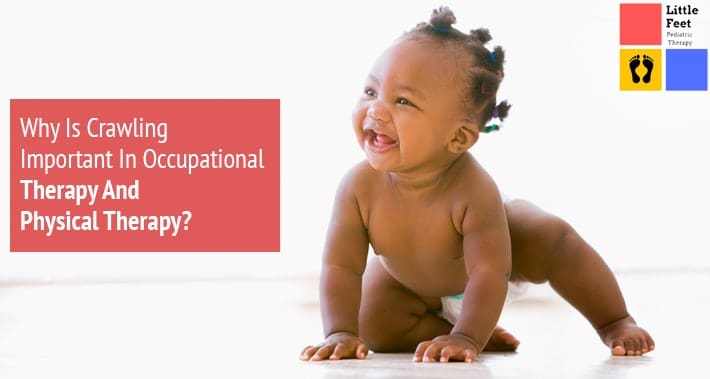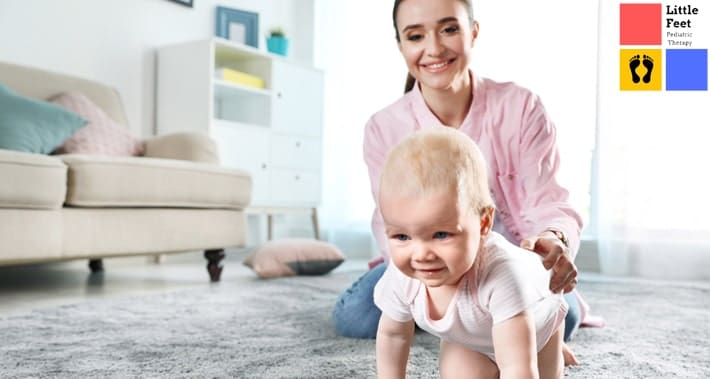
It’s no secret that crawling helps your baby develop the skills necessary for future walking.
But did you know just how important crawling is for your baby’s physical and neurological development?
Crawling helps your baby learn how to coordinate their limbs for a variety of other skills, such as:
- Feeding and dressing themselves
- Coloring
- Playing with toys
- Learning to write
Fortunately, there are many steps you can take to ensure your baby starts crawling.
But if they’re having trouble learning to crawl, it may cause other developmental delays.
Pediatric physical therapy for balance and coordination can help.
That’s where we come in.
We’re Little Feet Pediatric Therapy, a pediatric physical and occupational therapy clinic with a special interest in pediatric physical and occupational therapy for developmental delays.
In this article, we’ll explain why crawling is important for your child’s development, and what to do if they aren’t crawling.
What Is Crawling?
Crawling is your baby’s first form of independent locomotion.
It’s a period of childhood development where your baby puts weight on their hands and knees to build strength and stability for future walking.
In addition to helping develop future walking skills, crawling also helps develop your baby’s balance, sensory system, cognition, problem solving, and coordination.
RELATED: Pediatric Therapy For Child With Poor Balance And Coordination
There are two main types of crawling: belly crawling, or army crawling, and four point crawling.
Let’s take a closer look at each of them.
What Is Belly Crawling?
About half of all babies will begin crawling on their bellies.
This type of crawling involves keeping your belly against the floor while simultaneously pulling yourself forward.
They can use just their arms to pull, by only using one side of their body, or alternating arms and legs, often referred to as army crawling.
Babies who belly crawl tend to begin crawling faster than those who start with four point crawling.
This is because belly crawling takes significantly less strength and balance to master.
While it is preferred for babies to transition into four point crawling before walking, it is not always necessary.
What Is Four Point Crawling?
Also known as hands and knees crawling, four point crawling is where your baby places their hands and knees on the floor and coordinating them to produce movement.
Babies who use this method of crawling alternate their right and left legs to get one hand to meet the floor at the same time as their opposite leg.
This is called a reciprocal pattern.
Reciprocal crawling is important for your baby’s cognitive development.
This is because coordinating this movement requires the right and left side of the brain to communicate.
Are There Other Crawling Methods?
Absolutely.
Experts have observed 25 unique combination of body movements used by babies to crawl.
Some other methods of crawling include:
- Scooting on the bottom
- Using one foot or knee to push or pull
- Crab crawling
- Leap frogging
- Repetitive rolling
Although common, these forms of crawling may indicate that your baby is having difficulty coordinating the movements required for four-point crawling.
A pediatric physical therapist can help with methods to encourage your baby to start crawling in order to get all the associated benefits.
Why Is Crawling Important?
In addition to those already mentioned, crawling provides your baby with a variety of lifelong benefits.
Let’s take a closer look at some of them.
1. It Helps Build Stability And Strength
Crawling not only provides your baby with stability and strength of their trunk, arms and legs.
This helps them develop the gross motor skills they need to learn to walk.
Before they learn how to walk, babies must first strengthen their muscles and master their balance.
Four point crawling helps organize and shape the hip joint.
This is because it fits their leg bone, the femur, into the socket, the acetabulum.
Your baby’s hips reshape as the muscles strengthen and pull the bones forward and inwards.
This puts them in a better anatomical position for standing and walking.
Crawling also helps to build stability and strength in their trunk, arms, and hands.
This is important for developing fine motor skills such as holding a utensil, writing, and manipulating small objects.
It also helps strengthen muscles in their abdomen related to breathing, talking, and eating.
2. It Helps Build Crossing Midline Brain Connections
Imagine a line drawn right down the middle of your body – that’s your mid line.
Every time your baby crosses the mid line with their arms or legs, it builds connections in their brain.
These connections are beneficial later in life.
This occurs with four-point crawling.
Crossing midline is a fine motor skill which is important for developing vision, hearing, learning skills, handwriting, and primitive reflex integration.
RELATED: Pediatric Handwriting Therapy Near Me

3. It Helps Build Mind Body Coordination
Proper crawling form requires your baby to move their opposite arm and leg simultaneously.
So it requires the right and left hemispheres of their brain to communicate.
This communication takes place in an area of the brain called the corpus collusum.
The corpus collusum is a band of nerve fibers located between the two hemispheres.
It helps the two sides of your baby’s brain to communicate with each other.
This communication is a necessary stepping stone for more advanced motor skills like walking, running, riding a bike, getting dressed, and more self care skills development.
4. It Gives Them New Sensory Experiences
Through crawling, your baby is using five different sensory systems: skin, muscles and joints, ears, inner ears (vestibular system), and eyes.
This level of sensory information helps your baby better understand how their body fits into space and interacts with objects around it.
Is Crawling A Developmental Milestone?
Yes, learning to crawl is an important developmental milestone.
This is not to say that skipping crawling is always bad or harmful, but it should be encouraged, even after your child learns to walk for all the benefits above.
In most cases, your baby should be able to crawl by about 9 months.
That may be different if your baby has a developmental disorder, like cerebral palsy or Down syndrome.
What Happens If A Child Does Not Crawl?
In addition to missing out on the benefits of crawling that were discussed above, lack of crawling can cause issues for your child later in life.
Research suggests that babies who don’t crawl may exhibit learning difficulties later in life and fall behind in gross and fine motor skills.
If your baby isn’t crawling by 9 months, it is a good idea to see a licensed physical therapist to make sure that there are no underlying issues and to learn strategies to progress your little ones development – book your appointment with Little Feet Pediatric Therapy today for an assessment to find out.
How To Encourage Your Child To Crawl
Below are some physical therapy approved tips to help encourage your baby to crawl.
- Expose them to tummy time while playing and awake
- Prop a towel under their chest to provide support
- Make sure their elbows are under their shoulders to allow them to push up
- Give them as much floor time as possible and allow them to explore
- Minimize holding or propping your baby upright
- Limit use of containers which include Bumbo seats, exercise saucers, Dock a Tots, and anything that restricts movement
- Use a box, tunnel, pillows, or your legs as an obstacle for them to climb over
Book Your Appointment With Little Feet Pediatric Therapy Today
Are you looking for more information on crawling and its importance for your baby’s development?
At Little Feet Pediatric Therapy, we’re here to help you make the best decisions for your baby’s wellbeing.
Book your appointment with Little Feet Pediatric Therapy today.
► 3535 Randolph Rd, Charlotte, NC 28211
► 1331 H St NW Ste 200, Washington, DC 20005
► St. Louis, MO
► Raleigh, NC
Founded in 2019, Little Feet Therapy offers on site pediatric physical and occupational therapy treatments for children from 2 months to 18 years old with physical and developmental concerns. Our clinics focus on providing therapy in a child’s natural setting where your child is in familiar surroundings, it puts their mind at ease and helps them focus more on the work they’re doing with their pediatric therapist. Our therapists will work with your child at your home, at school, at daycare, or another place in the community where they feel most comfortable.